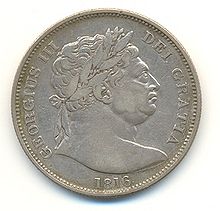
Dollar is the name of more than 25 currencies. The United States dollar, named after the international currency known as the Spanish dollar, was established in 1792 and is the first so named that still survives. Others include the Australian dollar, Brunei dollar, Canadian dollar, Eastern Caribbean dollar, Hong Kong dollar, Jamaican dollar, Liberian dollar, Namibian dollar, New Taiwan dollar, New Zealand dollar, Singapore dollar, Trinidad and Tobago Dollar and several others. The symbol for most of those currencies is the dollar sign $ in the same way as many countries using peso currencies. The name "dollar" originates from Bohemia and a 29 g silver-coin called the Joachimsthaler.

The standard circulating coinage of the United Kingdom, British Crown Dependencies and British Overseas Territories is denominated in pennies and pounds sterling, and ranges in value from one penny sterling to two pounds. Since decimalisation, on 15 February 1971, the pound has been divided into 100 (new) pence. Before decimalisation, twelve pence made a shilling, and twenty shillings made a pound.

The shilling is a historical coin, and the name of a unit of modern currencies formerly used in the United Kingdom, Australia, New Zealand, other British Commonwealth countries and Ireland, where they were generally equivalent to 12 pence or one-twentieth of a pound before being phased out during the 1960s and 1970s.

The five pound British gold coin, or quintuple sovereign, has a nominal value of five pounds sterling. It has been struck intermittently since 1820, though as a circulation coin only in 1887, 1893 and 1902. Through most of its history, it has depicted, on its reverse, Benedetto Pistrucci's portrayal of St George and the Dragon, which has traditionally been used on the sovereign, or one-pound gold coin.

The guinea was a coin, minted in Great Britain between 1663 and 1814, that contained approximately one-quarter of an ounce of gold. The name came from the Guinea region in West Africa, from where much of the gold used to make the coins was sourced. It was the first English machine-struck gold coin, originally representing a value of 20 shillings in sterling specie, equal to one pound, but rises in the price of gold relative to silver caused the value of the guinea to increase, at times to as high as thirty shillings. From 1717 to 1816, its value was officially fixed at twenty-one shillings.

Rupee is the common name for the currencies of India, Mauritius, Nepal, Pakistan, Seychelles, and Sri Lanka, and of former currencies of Afghanistan, Bahrain, Kuwait, Oman, the United Arab Emirates, British East Africa, Burma, German East Africa, and Tibet. In Indonesia and the Maldives, the unit of currency is known as rupiah and rufiyaa respectively, cognates of the word rupee.

The British crown was a denomination of sterling coinage worth 1⁄4 of one pound, or 5 shillings, or 60 (old) pence. The crown was first issued during the reign of Edward VI, as part of the coinage of the Kingdom of England.

The sovereign is a British gold coin with a nominal value of one pound sterling (£1) and contains 0.2354 troy oz of pure gold. Struck since 1817, it was originally a circulating coin that was accepted in Britain and elsewhere in the world; it is now a bullion coin and is sometimes mounted in jewellery. In addition, circulation strikes and proof examples are often collected for their numismatic value. In most recent years, it has borne the design of Saint George and the Dragon on the reverse; the initials of the designer, Benedetto Pistrucci, are visible to the right of the date.

Sterling is the currency of the United Kingdom and nine of its associated territories. The pound is the main unit of sterling, and the word "pound" is also used to refer to the British currency generally, often qualified in international contexts as the British pound or the pound sterling.
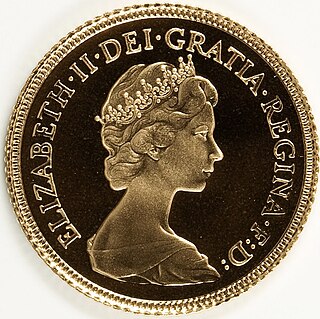
The half sovereign is a British gold coin denominated at one-half of a pound sterling. First issued in its present form in 1817, it has been struck by the Royal Mint in most years since 1980 as a collector's and bullion piece.
The British West Indies dollar (BWI$) was the currency of British Guiana and the Eastern Caribbean territories of the British West Indies from 1949 to 1965, when it was largely replaced by the East Caribbean dollar, and was one of the currencies used in Jamaica from 1954 to 1964. The monetary policy of the currency was overseen by the British Caribbean Currency Board (BCCB). It was the official currency used by the West Indies Federation The British West Indies dollar was never used in British Honduras, the Cayman Islands, the Turks and Caicos Islands, the Bahamas, or Bermuda.
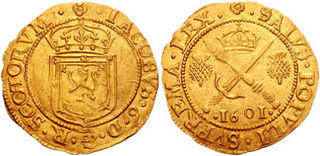
The pound was the currency of Scotland prior to the 1707 Treaty of Union between the Kingdom of Scotland and the Kingdom of England, which created the Kingdom of Great Britain. It was introduced by David I, in the 12th century, on the Carolingian monetary system of a pound divided into 20 shillings, each of 12 pence. The Scottish currency was later devalued relative to sterling by debasement of its coinage. By the time of James III, one pound Scots was valued at five shillings sterling.

The pound was the currency of Australia from 1910 until 14 February 1966, when it was replaced by the Australian dollar. Like other £sd currencies, it was subdivided into 20 shillings, each of 12 pence.
From c. 1124 until 1709 the coinage of Scotland was unique, and minted locally. A wide variety of coins, such as the plack, bodle, bawbee, dollar and ryal were produced over that time. For trading purposes coins of Northumbria and various other places had been used before that time; and since 1709 those of the Kingdom of Great Britain, and then of the UK.
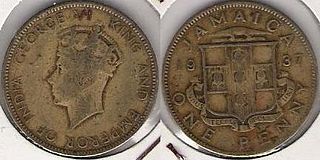
The pound was the official currency of Jamaica between 1840 and 1969. It circulated as a mixture of sterling coinage and locally issued coins and banknotes and was always equal to the pound sterling. The Jamaican pound was also used in the Cayman and Turks and Caicos Islands.
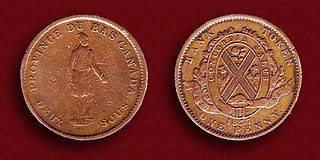
The pound was the currency of the Canadas until 1858. It was subdivided into 20 shillings (s), each of 12 pence (d). In Lower Canada, the sou was used, equivalent to a halfpenny. Although the £sd accounting system had its origins in sterling, the Canadian pound was never at par with sterling's pound.

The British shilling, abbreviated "1s" or "1/-", was a unit of currency and a denomination of sterling coinage worth 1⁄20 of one pound, or twelve pence. It was first minted in the reign of Henry VII as the testoon, and became known as the shilling, from the Old English scilling, sometime in the mid-16th century. It circulated until 1990. The word bob was sometimes used for a monetary value of several shillings, e.g. "ten-bob note". Following decimalisation on 15 February 1971 the coin had a value of five new pence, and a new coin of the same value but labelled as "five new pence" or "five pence" was minted with the same size as the shilling until 1990, after which the shilling no longer remained legal tender. It was made from silver from its introduction in or around 1503 until 1946, and thereafter in cupronickel.

The Coinage Act 1816, also known as the Coin Act 1816 or Liverpool's Act, defined the value of the pound sterling relative to gold. One troy pound of standard (22-carat) gold was defined as equivalent to £46 14s 6d., i.e. 44½ guineas, the guinea having been fixed in December 1717 at £1 1s exactly. According to its preamble, the purposes of the Act were to:

The double sovereign is a gold coin of the United Kingdom with a nominal value of two pounds sterling (£2). Rarely issued in the first century and a half after its debut in 1820, it never had a significant presence in circulation. It is now a collector and bullion coin, and has been struck most years since 1980. It features the reigning monarch on its obverse and, most often, Benedetto Pistrucci's depiction of Saint George and the Dragon on the reverse.
Prior to European colonization, early Aboriginal Australian communities traded using items such as tools, food, ochres, shells, raw materials and stories, although there is no evidence of the use of currencies.
